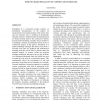Free Online Productivity Tools
i2Speak
i2Symbol
i2OCR
iTex2Img
iWeb2Print
iWeb2Shot
i2Type
iPdf2Split
iPdf2Merge
i2Bopomofo
i2Arabic
i2Style
i2Image
i2PDF
iLatex2Rtf
Sci2ools
120
Voted
WSC
1997
1997
Petri Net Based Simulation of Construction Schedules
Scheduling of a construction project requires: a) hierarchical decomposition of the project; b) incorporation of risk and uncertainty in the activity time and cost estimates; and c) modeling of dynamically allocated resources. Traditional network techniques that are being currently used by the construction industry provide limited modeling versatility and are ineffective in modeling a dynamic and stochastic system such as a construction project. In this paper a description of a hybrid scheduling technique that utilizes Petri Nets is provided. Petri Nets are graphical and mathematical modeling tools that can be used to perform static and dynamic analysis of systems. Under the proposed technique transitions and places, the two key elements of a Generalized Stochastic Petri Net (GSPN) are used to model the work tasks in a construction project. This automatically allows the incorporation of risk and uncertainty in the time and cost estimates of work tasks. Dynamic modeling of resources re...
Related Content
| Added | 01 Nov 2010 |
| Updated | 01 Nov 2010 |
| Type | Conference |
| Year | 1997 |
| Where | WSC |
| Authors | Anil Sawhney |
Comments (0)

